7 February 2025
Weekly Market View
The “Tariff man” or
‘The Art of the Deal’?
US President Donald Trump calls himself a “Tariff man”. He is also the author of a 1980s bestseller ‘The Art of the Deal’. For investors assessing which of the two facets of the US president will dominate his second term, his first two weeks suggest tariffs will play a more prominent role this time, likely causing market volatility.
Although markets are likely to restrain his more ambitious agenda, rising trade uncertainty reinforces the need to maintain a diversified foundation allocation, with a preference for US assets and gold.
China’s low-cost AI model DeepSeek is a wake-up call for US tech giants to make their AI investments more efficient. History shows low-cost technological breakthroughs increase the size of the pie. We see room for rotation within the technology sector, likely benefiting software and infrastructure sub-sectors.
While US tariffs are a near-term threat, China’s technology sector is likely to be a long-term beneficiary of wider AI adoption, reinforcing our bullish view on the Hong Kong Technology index.
What are DeepSeek’s implications for global equities?
Do you expect JPY to extend this year’s outperformance vs. other G10 currencies?
What are the implications of India’s annual budget for domestic equities?
Charts of the week: When gold shines…
Gold’s outperformance over the past year and year-to-date reflects heightened uncertainty around US policy
Performance of key asset classes, 12m and year-to-date return
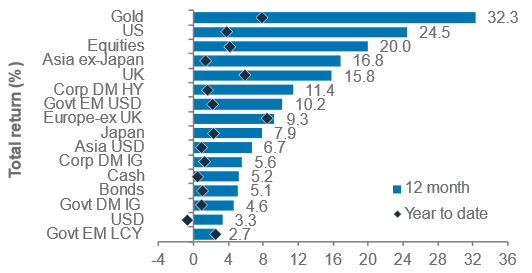
US government bond yields and S&P500 index in 2018-19*
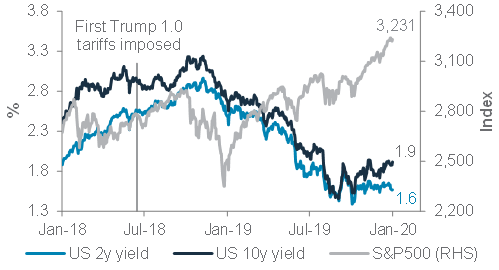
Source: Bloomberg, Standard Chartered; *Indicates market impact of trade war during Trump’s first presidency
Editorial
The “Tariff man” or ‘The Art of the Deal’?
US President Trump calls himself a “Tariff man”, extolling the virtues of protectionist duties to tackle US economic and social challenges. He is also the author of a 1980s bestseller ‘The Art of the Deal’ which provides insight into the way he thinks about business dealmaking. For investors assessing which of the two facets of the US president will dominate his second term, his first two weeks suggest tariffs will play a more prominent role this time, likely increasing market turbulence this year. Although markets are likely to eventually restrain his ambitious agenda, rising uncertainty reinforces the need to maintain a diversified foundation allocation, with a preference for US assets and gold. Alternative assets such as private equity and debt and real estate, thanks to their historically low correlation with equities and bonds, should also help reduce portfolio volatility.
‘Tariff man’ strikes: The US president, after indicating on inauguration day he may go soft on tariffs, imposed stiffer-than-expected 25% import duties on Canada and Mexico. He then postponed the duties for a month after his counterparts pledged tighter border controls. Trump’s 10% additional tariff on imports from China stands, doubling the average tariff rate to 20%. China has retaliated with targeted tariffs and started anti-trust investigations on some US technology leaders. Meanwhile, Europe’s leaders have been warned stiff tariffs are coming.
Vulnerable trade partners: US trading partners are more vulnerable to US tariffs today, compared with Trump 1.0, as the size of the US trade deficit has almost doubled since the start of the pandemic, led by deficits with the EU and Mexico. Almost a third of Mexico’s GDP, a fifth of Canada’s GDP and a fifth of EU’s global exports come from exports to the US. This gives the US president more leverage to use tariffs as a powerful negotiating tool to extract concessions. This is consistent with our Overweight stance on US assets in our portfolios.
US policy uncertainty spurs gold to record high. Gold has risen 9% this year, making it the best performing major asset class. If the announced tariffs against Canada, Mexico and China stand, the effective US tariff rate will soar to c. 10%, the highest since 1946, from 2.3% currently. Studies show tariffs boost short-term inflation but hurt medium-term growth. Using Fed models from Trump’s first term, Bloomberg Economics estimated the proposed tariffs, if passed through to consumers, could lift US core inflation by 0.7% and cut US GDP by 1.2%. However, supply disruptions (especially to auto and energy sectors), retaliation from trade partners and USD moves mean the actual impact could vary significantly. The uncertainty is likely to keep the Fed on hold for now and gold well bid.
Tariffs as a revenue source: Unlike Trump’s first term, tariff proceeds are likely to be a key component of funding proposed tax cuts. Investors are waiting for Treasury Secretary Scott Bessent, a proponent of measured tariffs, to lay out his tax plans. Elon Musk’s ability to cut government spending will also determine how much taxes can be cut without unsettling bond markets. An ambitious programme to deliver most of Trump’s tax cut promises made during the election would require tariffs to be more widely used and be longer lasting.
Restrained by Mr. Market. Trump’s quick reversal on Canada and Mexico tariffs after US equities sagged suggests markets are likely to remain vital constraints on Trump’s policies. Almost 40% of S&P500 companies’ revenues and 57% of technology sector revenues are sourced from abroad, leaving them exposed to trade disruptions. While this should give investors some assurance against extreme policies, it emphasises the need to balance traditional portfolios with gold and alternative assets to moderate volatility.
China likely to counter with fiscal stimulus. The additional 10% tariff on China is likely to directly reduce its GDP growth by c. 0.5%, but the indirect impact is likely to be greater. Although China has reduced its direct exposure to the US via exports in recent years, it is more reliant on global trade. It also faces deflation challenges at home. We expect Beijing to ease fiscal and monetary policy in the coming weeks to counter the impact of US tariffs. Authorities have kept the currency stable through daily FX fixing, sustaining the possibility of a trade deal.
The weekly macro balance sheet
Our weekly net assessment: On balance, we see the past week’s data and policy as negative for risk assets in the near-term
(+) factors: US manufacturing recovery
(-) factors: US, China services slowdown; US-China trade tensions; cautious Fed
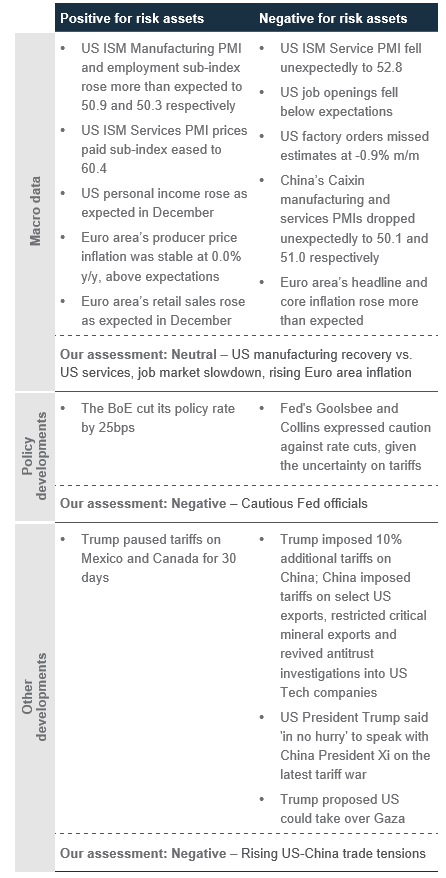
US manufacturing recovered in January, but services slowed; job openings remain on downtrend, suggesting a cooling job market
US ISM manufacturing and services PMIs; JOLTS job openings
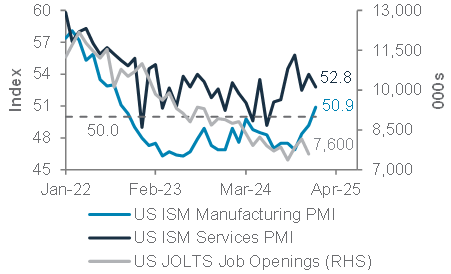
Euro area inflation remains sticky, although weaker growth and trade uncertainty is likely to allow the ECB to keep cutting rates
Euro area headline and core inflation
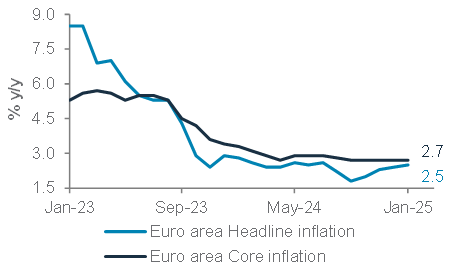
China faces increasing urgency to ease policy further as domestic economy remains lacklustre, while exports face rising US protectionism
China’s Caixin manufacturing and services PMIs
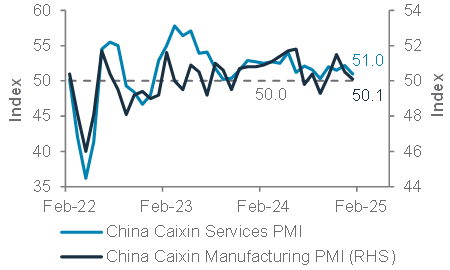
Source: Bloomberg, Standard Chartered
Top client questions
What are DeepSeek’s implications for global equities?
The emergence of DeepSeek, a cheap-cost alternative to OpenAI, has profound implications to global technology investing. It will lead to companies emphasising upon the efficiency of AI-investments, i.e. demanding more “bang-for-the-buck” for their AI-investments. Hyperscalers, i.e. large cloud service providers, are likely to remain aggressive with AI spend, though the mix may change. They will likely require more efficient chips and greater compute, as they accelerate AI adoption and the development of “higher-end” areas, e.g. agentic and physical AI.
We believe this is going to increase the “size of the pie” in the AI-industry, which is positive for the long-term, and hence, our stance to buy on dips in the broader US technology and communication services sectors. However, in the near-term, there is likely to be volatility ahead still in specific industries or stocks. Thus, within the technology sector, investors should use the “scaling-in” approach, to areas such as semiconductors and related equipment, where we expect valuation multiples to compress.
We also expect rotation within the technology sector. Software companies will likely benefit more, due to the Trump effect, e.g. no tariff headwinds, increased M&A, and AI monetisation. Large software-as-a-service providers with access to customer data will benefit from the emergence of low-cost solutions such as DeepSeek.
We remain overweight US equities. 5,800 is a key support for the S&P 500, followed by 5,650. Of the 58% of US companies that have reported Q4’24 results, 76% beat earnings expectations, above the “average beat” of 67%. Q4’24 earnings growth forecast has gone up to 12.7% y/y from 9.6% in the beginning of 2025. 9 out of 11 sectors delivered positive earnings surprises, led by Financials and Communications. The guidance from mega-cap growth companies has been mixed, citing headwinds from the USD and capacity additions from cloud growth, but we believe demand outlook remains healthy.
From a global perspective, Chinese technology companies linked to the development of AI will likely benefit. We have seen a slight rotation into Chinese equities since the end of Jan-25. While the trade war is a key macro risk, DeepSeek is a positive surprise for Chinese equities, narrowing the discount of Chinese equities vs. global ones. We expect this to push up the floor of the Hang Seng Index to the 20,000 level. In summary, we recommend a core allocation into China within our Neutral stance in Asia ex-Japan equities, advocating a “barbell approach” of positioning into high-dividend non-financial state-owned enterprises and the Hang Seng Technology Index.
— Daniel Lam, Head, Equity Strategy
US financial and communication services sectors have led earnings surprises in the Q4 2024 reporting season
Earnings surprises of S&P 500 sectors in Q4’24

LSEG I/B/E/S, Standard Chartered
The Hang Seng Index’s likely technical support level has risen to the 20,000 level
Hang Seng Index
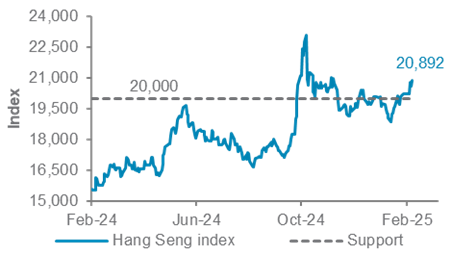
Source: Bloomberg, Standard Chartered
Top client questions (cont’d)
What are the implications of India’s annual budget for Indian equities?
India’s annual budget for 2025 attempts to boost growth while staying on the path of fiscal consolidation. A sizeable income tax cut (~0.3% of GDP) for individuals with annual incomes below INR 1.2 mn was a positive surprise. Other key announcements included
1) measures to boost employment and income through increased outlays for key employment sectors – agriculture, tourism, exports, and enhanced credit support for small-and-medium businesses and individuals; 2) increased deregulation to facilitate doing business, including tax rationalisation, rationalisation of duties and export tariffs, and incentivisation for energy distribution and transmission reforms; and 3) fiscal deficit set at 3.5% of GDP and central government debt-to-GDP ratio at 50% by FY 2031.
In our view, the budget sets a floor for GDP growth amid a cyclical slowdown. Improved discretionary spending power of consumers could drive a pick-up in private consumption. The focus on public-private-partnership (PPP) could boost private capex.
We find the budget supportive of our preference for Indian equities over a 12-month horizon. The market’s valuation has eased, with the Nifty index 12-month forward P/E falling to 19x from September 2024 peak of 21x. Additionally, India is less prone to the intensifying tariff war. While volatility may remain elevated in the near-term, we would adopt a buy-on-dip strategy to add the asset class.
— Ravi Singh, Chief Investment Strategist
Indian budget stuck to its fiscal consolidation path while providing a growth boost
Key numbers from the Budget
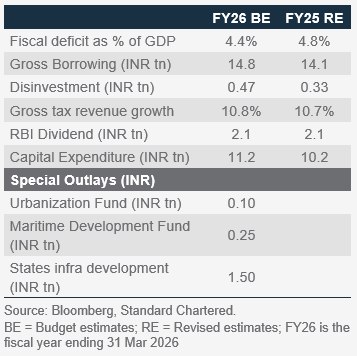
Do you expect JPY to extend this year’s outperformance against other G10 currencies?
JPY has been the strongest currency among G7 since the start of the year. USD/JPY has fallen 3.2% year-to-date. Notably, Japan’s inflation-adjusted real wages rose 0.6% year-on-year in December, driven by winter bonuses. Markets continue to price BoJ rate hikes, with 30 bps expected by year-end. Meanwhile BoJ board member Naoki Tamura suggested rates should rise to around 1% by the fiscal year ending March 2026. We consider the pair likely to test support at 149.2 and the yen to appreciate on the back of further hawkish comments amid potential tariff-related developments. We prefer to express this against commodity currencies.
Australia’s underlying inflation fell from 3.6% to 3.2% y/y in the December quarter and retail sales softened m/m. The market is pricing in 90 bps of RBA rate cuts by year-end. With expectations of a dovish RBA tilt next week, we have a bearish stance on AUD/JPY. A firm break below 93.59 is likely to edge towards 90.15.
— Iris Yuen, Investment Strategist
We expect further AUD/JPY downside
AUD/JPY and technicals
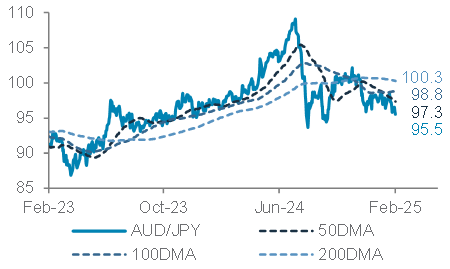
Source: Bloomberg, Standard Chartered
Top client questions (cont’d)
What’s the outlook for GBP/USD after the BOE policy meeting?
The BoE cut its policy rate by 25bps as the market widely expected, marking the lowest level since June 2023. However, two officials backed a 50bps cut, fuelling market expectations of further easing, which is supported on the UK fundamental front: unemployment climbed, core inflation fell from 3.5% to 3.2% in December, and consumer confidence fell more than expected in January.
However, the retreat of UK gilts since mid-January and the tax rise are likely to alleviate the UK government debt stress. We expect to see some fiscal stability, which will support the GBP in the coming months. Additionally, GBP is less sensitive to tariff, along with neutral technical signals. Hence, GBP/USD is likely to be rangebound between 1.2100-1.2810 in the next 3 months.
— Iris Yuen, Investment Strategist
GBP/USD is likely to be rangebound
GBP/USD with technicals
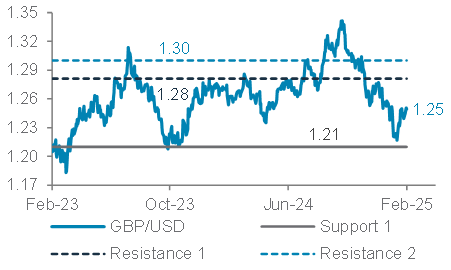
Source: Bloomberg, Standard Chartered
What are the implications of the US Treasury Department’s quarterly refunding announcement? What is your expectation for the term premium?
The US Treasury, as anticipated, maintained a stable refunding plan in its February 5 announcement. However, uncertainty remains regarding how the expected tax cuts under the Trump administration will be funded. Generally, the market expects the US Treasury to have enough leeway until the third quarter of 2025 to utilize accounting measures and draw on its cash balance to avoid a debt-ceiling breach, thereby keeping volatility in check.
The US 10-year yield has retreated from a high of 4.8% in mid-January to below 4.5% following the lower-than-expected CPI print and weaker January ISM Services Index. Yield volatility remained contained earlier this week amid the ongoing tariff disputes. Similarly, the US Treasury 2-year to 10-year spread has flattened from 42bps to the current 23bps.
We expect the 10-year yield to be in the range of 4% to 4.25% in 6-12 months and anticipate three cuts to the Fed funds rate in 2025. This implies that the term premium, the extra interest rates an investor would demand to lend their money out for a longer time, will remain relatively stable while the yield curve shifts lower. We reiterate our recommendation for investors to lock in current yields given our view that interest rates will move lower from the current higher levels.
— Ray Heung, Senior Investment Strategist
US 10-year government bond yield has fallen below 4.5% amid growth concerns as trade uncertainty rise
US 2-year and 10-year government bond yields
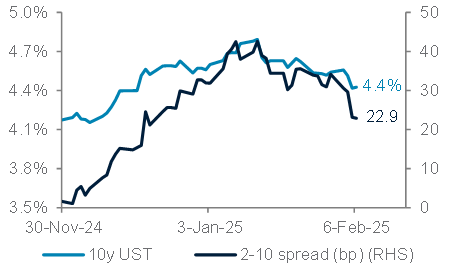
Source: Bloomberg, Standard Chartered
Market performance summary*
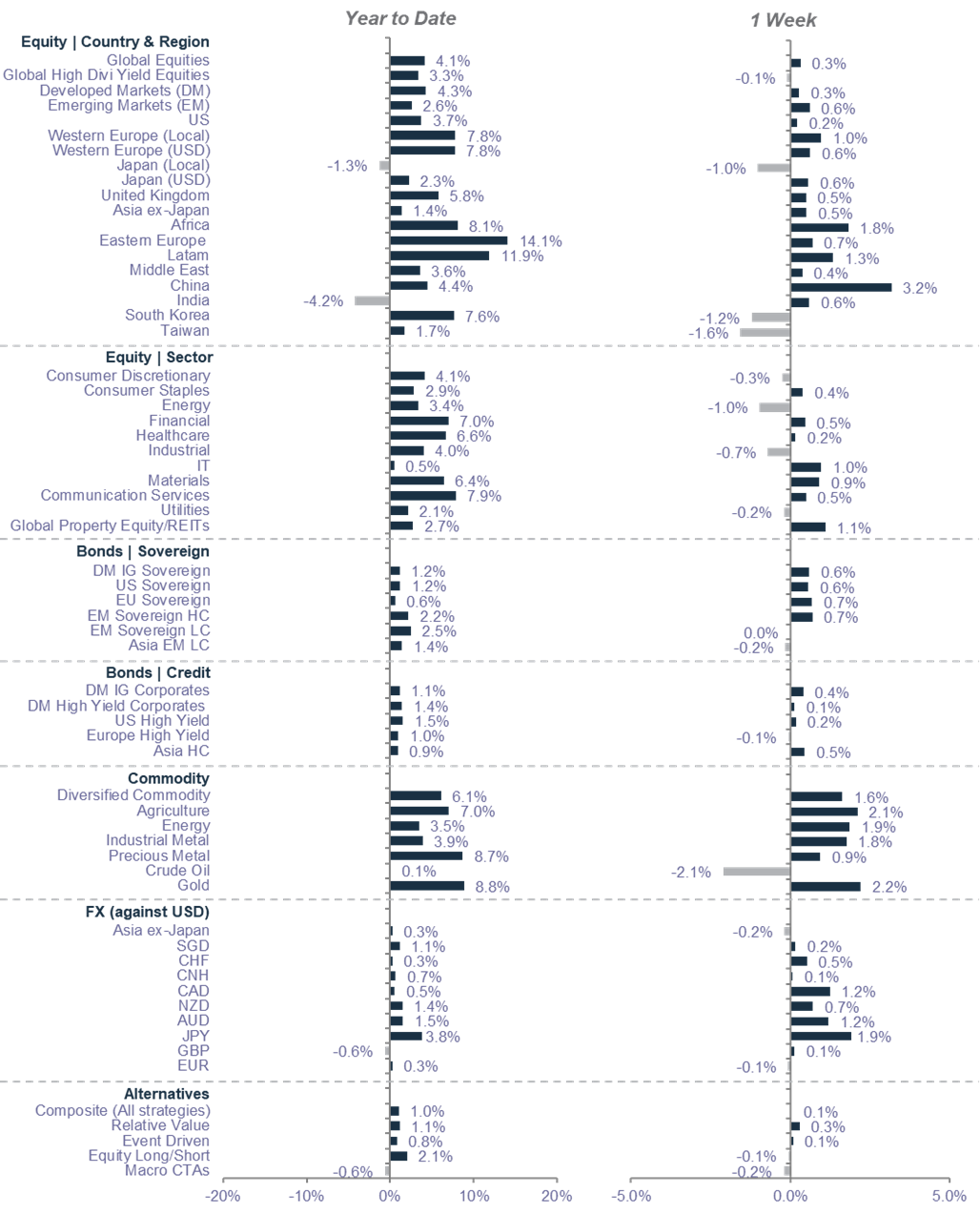
Sources: MSCI, JP Morgan, Barclays Capital, Citigroup, Dow Jones, HFRX, FTSE, Bloomberg, Standard Chartered. *Performance in USD terms unless otherwise stated 2025 YTD performance from 31 Dec 2024-6 Feb 2025; 1-week period: 30 Jan-6 Feb 2025
Our 12-month asset class views at a glance
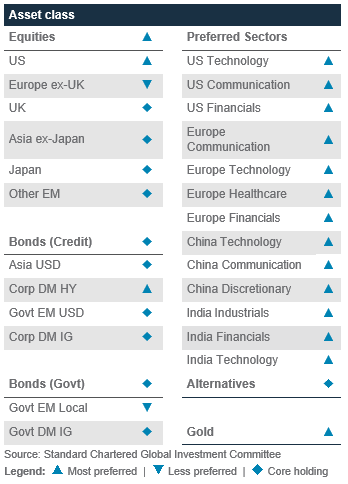
Economic and market calendar
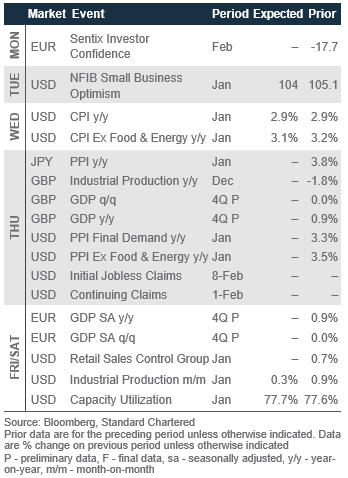
The S&P500 has next interim resistance at 6,217
Technical indicators for key markets as of 6 Feb close
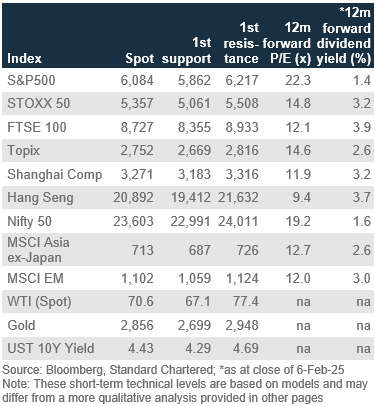
Investor diversity has normalised across asset classes
Our proprietary market diversity indicators as of 6 Feb close
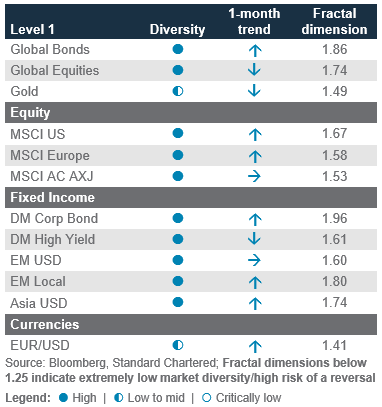

Disclosure
This document is confidential and may also be privileged. If you are not the intended recipient, please destroy all copies and notify the sender immediately. This document is being distributed for general information only and is subject to the relevant disclaimers available at our Standard Chartered website under Regulatory disclosures. It is not and does not constitute research material, independent research, an offer, recommendation or solicitation to enter into any transaction or adopt any hedging, trading or investment strategy, in relation to any securities or other financial instruments. This document is for general evaluation only. It does not take into account the specific investment objectives, financial situation or particular needs of any particular person or class of persons and it has not been prepared for any particular person or class of persons. You should not rely on any contents of this document in making any investment decisions. Before making any investment, you should carefully read the relevant offering documents and seek independent legal, tax and regulatory advice. In particular, we recommend you to seek advice regarding the suitability of the investment product, taking into account your specific investment objectives, financial situation or particular needs, before you make a commitment to purchase the investment product. Opinions, projections and estimates are solely those of SC at the date of this document and subject to change without notice. Past performance is not indicative of future results and no representation or warranty is made regarding future performance. The value of investments, and the income from them, can go down as well as up, and you may not recover the amount of your original investment. You are not certain to make a profit and may lose money. Any forecast contained herein as to likely future movements in rates or prices or likely future events or occurrences constitutes an opinion only and is not indicative of actual future movements in rates or prices or actual future events or occurrences (as the case may be). This document must not be forwarded or otherwise made available to any other person without the express written consent of the Standard Chartered Group (as defined below). Standard Chartered Bank is incorporated in England with limited liability by Royal Charter 1853 Reference Number ZC18. The Principal Office of the Company is situated in England at 1 Basinghall Avenue, London, EC2V 5DD. Standard Chartered Bank is authorised by the Prudential Regulation Authority and regulated by the Financial Conduct Authority and Prudential Regulation Authority. Standard Chartered PLC, the ultimate parent company of Standard Chartered Bank, together with its subsidiaries and affiliates (including each branch or representative office), form the Standard Chartered Group. Standard Chartered Private Bank is the private banking division of Standard Chartered. Private banking activities may be carried out internationally by different legal entities and affiliates within the Standard Chartered Group (each an “SC Group Entity”) according to local regulatory requirements. Not all products and services are provided by all branches, subsidiaries and affiliates within the Standard Chartered Group. Some of the SC Group Entities only act as representatives of Standard Chartered Private Bank and may not be able to offer products and services or offer advice to clients.
Copyright © 2025, Accounting Research & Analytics, LLC d/b/a CFRA (and its affiliates, as applicable). Reproduction of content provided by CFRA in any form is prohibited except with the prior written permission of CFRA. CFRA content is not investment advice and a reference to or observation concerning a security or investment provided in the CFRA SERVICES is not a recommendation to buy, sell or hold such investment or security or make any other investment decisions. The CFRA content contains opinions of CFRA based upon publicly-available information that CFRA believes to be reliable and the opinions are subject to change without notice. This analysis has not been submitted to, nor received approval from, the United States Securities and Exchange Commission or any other regulatory body. While CFRA exercised due care in compiling this analysis, CFRA, ITS THIRD-PARTY SUPPLIERS, AND ALL RELATED ENTITIES SPECIFICALLY DISCLAIM ALL WARRANTIES, EXPRESS OR IMPLIED, INCLUDING, BUT NOT LIMITED TO, ANY WARRANTIES OF MERCHANTABILITY OR FITNESS FOR A PARTICULAR PURPOSE OR USE, to the full extent permitted by law, regarding the accuracy, completeness, or usefulness of this information and assumes no liability with respect to the consequences of relying on this information for investment or other purposes. No content provided by CFRA (including ratings, credit-related analyses and data, valuations, model, software or other application or output therefrom) or any part thereof may be modified, reverse engineered, reproduced or distributed in any form by any means, or stored in a database or retrieval system, without the prior written permission of CFRA, and such content shall not be used for any unlawful or unauthorized purposes. CFRA and any third-party providers, as well as their directors, officers, shareholders, employees or agents do not guarantee the accuracy, completeness, timeliness or availability of such content. In no event shall CFRA, its affiliates, or their third-party suppliers be liable for any direct, indirect, special, or consequential damages, costs, expenses, legal fees, or losses (including lost income or lost profit and opportunity costs) in connection with a subscriber’s, subscriber’s customer’s, or other’s use of CFRA’s content.
Market Abuse Regulation (MAR) Disclaimer
Banking activities may be carried out internationally by different branches, subsidiaries and affiliates within the Standard Chartered Group according to local regulatory requirements. Opinions may contain outright “buy”, “sell”, “hold” or other opinions. The time horizon of this opinion is dependent on prevailing market conditions and there is no planned frequency for updates to the opinion. This opinion is not independent of Standard Chartered Group’s trading strategies or positions. Standard Chartered Group and/or its affiliates or its respective officers, directors, employee benefit programmes or employees, including persons involved in the preparation or issuance of this document may at any time, to the extent permitted by applicable law and/or regulation, be long or short any securities or financial instruments referred to in this document or have material interest in any such securities or related investments. Therefore, it is possible, and you should assume, that Standard Chartered Group has a material interest in one or more of the financial instruments mentioned herein. Please refer to our Standard Chartered website under Regulatory disclosures for more detailed disclosures, including past opinions/ recommendations in the last 12 months and conflict of interests, as well as disclaimers. A covering strategist may have a financial interest in the debt or equity securities of this company/issuer. This document must not be forwarded or otherwise made available to any other person without the express written consent of Standard Chartered Group.
Sustainable Investments
Any ESG data used or referred to has been provided by Morningstar, Sustainalytics, MSCI or Bloomberg. Refer to 1) Morningstar website under Sustainable Investing, 2) Sustainalytics website under ESG Risk Ratings, 3) MCSI website under ESG Business Involvement Screening Research and 4) Bloomberg green, social & sustainability bonds guide for more information. The ESG data is as at the date of publication based on data provided, is for informational purpose only and is not warranted to be complete, timely, accurate or suitable for a particular purpose, and it may be subject to change. Sustainable Investments (SI): This refers to funds that have been classified as ‘Sustainable Investments’ by Morningstar. SI funds have explicitly stated in their prospectus and regulatory filings that they either incorporate ESG factors into the investment process or have a thematic focus on the environment, gender diversity, low carbon, renewable energy, water or community development. For equity, it refers to shares/stocks issued by companies with Sustainalytics ESG Risk Rating of Low/Negligible. For bonds, it refers to debt instruments issued by issuers with Sustainalytics ESG Risk Rating of Low/Negligible, and/or those being certified green, social, sustainable bonds by Bloomberg. For structured products, it refers to products that are issued by any issuer who has a Sustainable Finance framework that aligns with Standard Chartered’s Green and Sustainable Product Framework, with underlying assets that are part of the Sustainable Investment universe or separately approved by Standard Chartered’s Sustainable Finance Governance Committee. Sustainalytics ESG risk ratings shown are factual and are not an indicator that the product is classified or marketed as “green”, “sustainable” or similar under any particular classification system or framework.
Country/Market Specific Disclosures
Botswana: This document is being distributed in Botswana by, and is attributable to, Standard Chartered Bank Botswana Limited which is a financial institution licensed under the Section 6 of the Banking Act CAP 46.04 and is listed in the Botswana Stock Exchange. Brunei Darussalam: This document is being distributed in Brunei Darussalam by, and is attributable to, Standard Chartered Bank (Brunei Branch) | Registration Number RFC/61 and Standard Chartered Securities (B) Sdn Bhd | Registration Number RC20001003. Standard Chartered Bank is incorporated in England with limited liability by Royal Charter 1853 Reference Number ZC18. Standard Chartered Securities (B) Sdn Bhd is a limited liability company registered with the Registry of Companies with Registration Number RC20001003 and licensed by Brunei Darussalam Central Bank as a Capital Markets Service License Holder with License Number BDCB/R/CMU/S3-CL and it is authorised to conduct Islamic investment business through an Islamic window. China Mainland: This document is being distributed in China by, and is attributable to, Standard Chartered Bank (China) Limited which is mainly regulated by National Financial Regulatory Administration (NFRA), State Administration of Foreign Exchange (SAFE), and People’s Bank of China (PBOC). Hong Kong: In Hong Kong, this document, except for any portion advising on or facilitating any decision on futures contracts trading, is distributed by Standard Chartered Bank (Hong Kong) Limited (“SCBHK”), a subsidiary of Standard Chartered PLC. SCBHK has its registered address at 32/F, Standard Chartered Bank Building, 4-4A Des Voeux Road Central, Hong Kong and is regulated by the Hong Kong Monetary Authority and registered with the Securities and Futures Commission (“SFC”) to carry on Type 1 (dealing in securities), Type 4 (advising on securities), Type 6 (advising on corporate finance) and Type 9 (asset management) regulated activity under the Securities and Futures Ordinance (Cap. 571) (“SFO”) (CE No. AJI614). The contents of this document have not been reviewed by any regulatory authority in Hong Kong and you are advised to exercise caution in relation to any offer set out herein. If you are in doubt about any of the contents of this document, you should obtain independent professional advice. Any product named herein may not be offered or sold in Hong Kong by means of any document at any time other than to “professional investors” as defined in the SFO and any rules made under that ordinance. In addition, this document may not be issued or possessed for the purposes of issue, whether in Hong Kong or elsewhere, and any interests may not be disposed of, to any person unless such person is outside Hong Kong or is a “professional investor” as defined in the SFO and any rules made under that ordinance, or as otherwise may be permitted by that ordinance. In Hong Kong, Standard Chartered Private Bank is the private banking division of SCBHK, a subsidiary of Standard Chartered PLC. Ghana: Standard Chartered Bank Ghana Limited accepts no liability and will not be liable for any loss or damage arising directly or indirectly (including special, incidental or consequential loss or damage) from your use of these documents. Past performance is not indicative of future results and no representation or warranty is made regarding future performance. You should seek advice from a financial adviser on the suitability of an investment for you, taking into account these factors before making a commitment to invest in an investment. To unsubscribe from receiving further updates, please send an email to feedback.ghana@sc.com. Please do not reply to this email. Call our Priority Banking on 0302610750 for any questions or service queries. You are advised not to send any confidential and/or important information to Standard Chartered via e-mail, as Standard Chartered makes no representations or warranties as to the security or accuracy of any information transmitted via e-mail. Standard Chartered shall not be responsible for any loss or damage suffered by you arising from your decision to use e-mail to communicate with the Bank. India: This document is being distributed in India by Standard Chartered in its capacity as a distributor of mutual funds and referrer of any other third party financial products. Standard Chartered does not offer any ‘Investment Advice’ as defined in the Securities and Exchange Board of India (Investment Advisers) Regulations, 2013 or otherwise. Services/products related securities business offered by Standard Charted are not intended for any person, who is a resident of any jurisdiction, the laws of which imposes prohibition on soliciting the securities business in that jurisdiction without going through the registration requirements and/or prohibit the use of any information contained in this document. Indonesia: This document is being distributed in Indonesia by Standard Chartered Bank, Indonesia branch, which is a financial institution licensed, registered and supervised by Otoritas Jasa Keuangan (Financial Service Authority). Jersey: In Jersey, Standard Chartered Private Bank is the Registered Business Name of the Jersey Branch of Standard Chartered Bank. The Jersey Branch of Standard Chartered Bank is regulated by the Jersey Financial Services Commission. Copies of the latest audited accounts of Standard Chartered Bank are available from its principal place of business in Jersey: PO Box 80, 15 Castle Street, St Helier, Jersey JE4 8PT. Standard Chartered Bank is incorporated in England with limited liability by Royal Charter in 1853 Reference Number ZC 18. The Principal Office of the Company is situated in England at 1 Basinghall Avenue, London, EC2V 5DD. Standard Chartered Bank is authorised by the Prudential Regulation Authority and regulated by the Financial Conduct Authority and Prudential Regulation Authority. The Jersey Branch of Standard Chartered Bank is also an authorised financial services provider under license number 44946 issued by the Financial Sector Conduct Authority of the Republic of South Africa. Jersey is not part of the United Kingdom and all business transacted with Standard Chartered Bank, Jersey Branch and other SC Group Entity outside of the United Kingdom, are not subject to some or any of the investor protection and compensation schemes available under United Kingdom law. Kenya: This document is being distributed in Kenya by and is attributable to Standard Chartered Bank Kenya Limited. Investment Products and Services are distributed by Standard Chartered Investment Services Limited, a wholly owned subsidiary of Standard Chartered Bank Kenya Limited that is licensed by the Capital Markets Authority in Kenya, as a Fund Manager. Standard Chartered Bank Kenya Limited is regulated by the Central Bank of Kenya. Malaysia: This document is being distributed in Malaysia by Standard Chartered Bank Malaysia Berhad (“SCBMB”). Recipients in Malaysia should contact SCBMB in relation to any matters arising from, or in connection with, this document. This document has not been reviewed by the Securities Commission Malaysia. The product lodgement, registration, submission or approval by the Securities Commission of Malaysia does not amount to nor indicate recommendation or endorsement of the product, service or promotional activity. Investment products are not deposits and are not obligations of, not guaranteed by, and not protected by SCBMB or any of the affiliates or subsidiaries, or by Perbadanan Insurans Deposit Malaysia, any government or insurance agency. Investment products are subject to investment risks, including the possible loss of the principal amount invested. SCBMB expressly disclaim any liability and responsibility for any loss arising directly or indirectly (including special, incidental or consequential loss or damage) arising from the financial losses of the Investment Products due to market condition. Nigeria: This document is being distributed in Nigeria by Standard Chartered Bank Nigeria Limited (SCB Nigeria), a bank duly licensed and regulated by the Central Bank of Nigeria. SCB Nigeria accepts no liability for any loss or damage arising directly or indirectly (including special, incidental or consequential loss or damage) from your use of these documents. You should seek advice from a financial adviser on the suitability of an investment for you, taking into account these factors before making a commitment to invest in an investment. To unsubscribe from receiving further updates, please send an email to clientcare.ng@sc.com requesting to be removed from our mailing list. Please do not reply to this email. Call our Priority Banking on 02 012772514 for any questions or service queries. Standard Chartered shall not be responsible for any loss or damage arising from your decision to send confidential and/or important information to Standard Chartered via e-mail, as Standard Chartered makes no representations or warranties as to the security or accuracy of any information transmitted via e-mail. Pakistan: This document is being distributed in Pakistan by, and attributable to Standard Chartered Bank (Pakistan) Limited having its registered office at PO Box 5556, I.I Chundrigar Road Karachi, which is a banking company registered with State Bank of Pakistan under Banking Companies Ordinance 1962 and is also having licensed issued by Securities & Exchange Commission of Pakistan for Security Advisors. Standard Chartered Bank (Pakistan) Limited acts as a distributor of mutual funds and referrer of other third-party financial products. Singapore: This document is being distributed in Singapore by, and is attributable to, Standard Chartered Bank (Singapore) Limited (Registration No. 201224747C/ GST Group Registration No. MR-8500053-0, “SCBSL”). Recipients in Singapore should contact SCBSL in relation to any matters arising from, or in connection with, this document. SCBSL is an indirect wholly owned subsidiary of Standard Chartered Bank and is licensed to conduct banking business in Singapore under the Singapore Banking Act, 1970. Standard Chartered Private Bank is the private banking division of SCBSL. IN RELATION TO ANY SECURITY OR SECURITIES-BASED DERIVATIVES CONTRACT REFERRED TO IN THIS DOCUMENT, THIS DOCUMENT, TOGETHER WITH THE ISSUER DOCUMENTATION, SHALL BE DEEMED AN INFORMATION MEMORANDUM (AS DEFINED IN SECTION 275 OF THE SECURITIES AND FUTURES ACT, 2001 (“SFA”)). THIS DOCUMENT IS INTENDED FOR DISTRIBUTION TO ACCREDITED INVESTORS, AS DEFINED IN SECTION 4A(1)(a) OF THE SFA, OR ON THE BASIS THAT THE SECURITY OR SECURITIES-BASED DERIVATIVES CONTRACT MAY ONLY BE ACQUIRED AT A CONSIDERATION OF NOT LESS THAN S$200,000 (OR ITS EQUIVALENT IN A FOREIGN CURRENCY) FOR EACH TRANSACTION. Further, in relation to any security or securities-based derivatives contract, neither this document nor the Issuer Documentation has been registered as a prospectus with the Monetary Authority of Singapore under the SFA. Accordingly, this document and any other document or material in connection with the offer or sale, or invitation for subscription or purchase, of the product may not be circulated or distributed, nor may the product be offered or sold, or be made the subject of an invitation for subscription or purchase, whether directly or indirectly, to persons other than a relevant person pursuant to section 275(1) of the SFA, or any person pursuant to section 275(1A) of the SFA, and in accordance with the conditions specified in section 275 of the SFA, or pursuant to, and in accordance with the conditions of, any other applicable provision of the SFA. In relation to any collective investment schemes referred to in this document, this document is for general information purposes only and is not an offering document or prospectus (as defined in the SFA). This document is not, nor is it intended to be (i) an offer or solicitation of an offer to buy or sell any capital markets product; or (ii) an advertisement of an offer or intended offer of any capital markets product. Deposit Insurance Scheme: Singapore dollar deposits of non-bank depositors are insured by the Singapore Deposit Insurance Corporation, for up to S$100,000 in aggregate per depositor per Scheme member by law. Foreign currency deposits, dual currency investments, structured deposits and other investment products are not insured. This advertisement has not been reviewed by the Monetary Authority of Singapore. Taiwan: SC Group Entity or Standard Chartered Bank (Taiwan) Limited (“SCB (Taiwan)”) may be involved in the financial instruments contained herein or other related financial instruments. The author of this document may have discussed the information contained herein with other employees or agents of SC or SCB (Taiwan). The author and the above-mentioned employees of SC or SCB (Taiwan) may have taken related actions in respect of the information involved (including communication with customers of SC or SCB (Taiwan) as to the information contained herein). The opinions contained in this document may change, or differ from the opinions of employees of SC or SCB (Taiwan). SC and SCB (Taiwan) will not provide any notice of any changes to or differences between the above-mentioned opinions. This document may cover companies with which SC or SCB (Taiwan) seeks to do business at times and issuers of financial instruments. Therefore, investors should understand that the information contained herein may serve as specific purposes as a result of conflict of interests of SC or SCB (Taiwan). SC, SCB (Taiwan), the employees (including those who have discussions with the author) or customers of SC or SCB (Taiwan) may have an interest in the products, related financial instruments or related derivative financial products contained herein; invest in those products at various prices and on different market conditions; have different or conflicting interests in those products. The potential impacts include market makers’ related activities, such as dealing, investment, acting as agents, or performing financial or consulting services in relation to any of the products referred to in this document. UAE: DIFC – Standard Chartered Bank is incorporated in England with limited liability by Royal Charter 1853 Reference Number ZC18.The Principal Office of the Company is situated in England at 1 Basinghall Avenue, London, EC2V 5DD. Standard Chartered Bank is authorised by the Prudential Regulation Authority and regulated by the Financial Conduct Authority and Prudential Regulation Authority. Standard Chartered Bank, Dubai International Financial Centre having its offices at Dubai International Financial Centre, Building 1, Gate Precinct, P.O. Box 999, Dubai, UAE is a branch of Standard Chartered Bank and is regulated by the Dubai Financial Services Authority (“DFSA”). This document is intended for use only by Professional Clients and is not directed at Retail Clients as defined by the DFSA Rulebook. In the DIFC we are authorised to provide financial services only to clients who qualify as Professional Clients and Market Counterparties and not to Retail Clients. As a Professional Client you will not be given the higher retail client protection and compensation rights and if you use your right to be classified as a Retail Client we will be unable to provide financial services and products to you as we do not hold the required license to undertake such activities. For Islamic transactions, we are acting under the supervision of our Shariah Supervisory Committee. Relevant information on our Shariah Supervisory Committee is currently available on the Standard Chartered Bank website in the Islamic banking section. For residents of the UAE – Standard Chartered Bank UAE does not provide financial analysis or consultation services in or into the UAE within the meaning of UAE Securities and Commodities Authority Decision No. 48/r of 2008 concerning financial consultation and financial analysis. Uganda: Our Investment products and services are distributed by Standard Chartered Bank Uganda Limited, which is licensed by the Capital Markets Authority as an investment adviser. United Kingdom: In the UK, Standard Chartered Bank is authorised by the Prudential Regulation Authority and regulated by the Financial Conduct Authority and Prudential Regulation Authority. This communication has been approved by Standard Chartered Bank for the purposes of Section 21 (2) (b) of the United Kingdom’s Financial Services and Markets Act 2000 (“FSMA”) as amended in 2010 and 2012 only. Standard Chartered Bank (trading as Standard Chartered Private Bank) is also an authorised financial services provider (license number 45747) in terms of the South African Financial Advisory and Intermediary Services Act, 2002. The Materials have not been prepared in accordance with UK legal requirements designed to promote the independence of investment research, and that it is not subject to any prohibition on dealing ahead of the dissemination of investment research. Vietnam: This document is being distributed in Vietnam by, and is attributable to, Standard Chartered Bank (Vietnam) Limited which is mainly regulated by State Bank of Vietnam (SBV). Recipients in Vietnam should contact Standard Chartered Bank (Vietnam) Limited for any queries regarding any content of this document. Zambia: This document is distributed by Standard Chartered Bank Zambia Plc, a company incorporated in Zambia and registered as a commercial bank and licensed by the Bank of Zambia under the Banking and Financial Services Act Chapter 387 of the Laws of Zambia.
